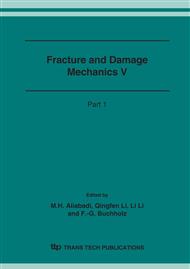p.663
p.667
p.671
p.675
p.679
p.683
p.687
p.691
p.695
Dynamics of a Mode III Crack Impacted by Elastic Wave in Half Space with a Removable Rigid Cylindrical Inclusion
Abstract:
Scattering of SH wave by a crack is studied in elastic half space with a removable rigid cylindrical inclusion by Green’s function, complex function and moving coordinate method. In half space, firstly the scattering wave function of removable rigid cylindrical inclusion is constructed; next a suitable Green’s function is solved for present problem, then using crack-division to make a crack. Thus the solution of problem can be obtained. Numerical examples are provided and discussed.
Info:
Periodical:
Pages:
679-682
Citation:
Online since:
November 2006
Authors:
Price:
Сopyright:
© 2006 Trans Tech Publications Ltd. All Rights Reserved
Share:
Citation:


